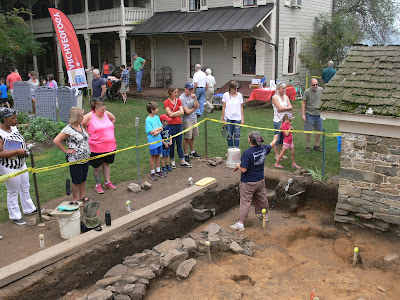Fort Hunter Day 2017
In the remaining two weeks of fieldwork at Fort Hunter since
our last post, our crew continued to excavate in their respective areas to the
east and west of the milk house behind the mansion. Never a day went by without
the archaeologists answering questions from the curious and inquisitive
visitors to the park. How do you know where to dig? What are you finding? Did
you have to go to school for that?
In the vicinity of the smokehouse foundation, artifacts were
few and far between, suggesting that undisturbed soils with the potential to
contain historic, and more optimistically fort period artifacts, had been all
but exhausted through previous years’ work in this area. Careful troweling of
the remaining soil did yield a handful of glazed redware sherds, very small
fragments of tin-glazed earthenware and scratch blue salt-glazed stoneware. With
disassembly of the smokehouse foundation completed and samples of visually
distinct stones set aside for thin sectioning and sourcing analysis, the excavation
block east of the milk house has closed and is ready to be backfilled.
East block closing shot
Notable discoveries in the excavation units to the west of
the milk house were predominantly prehistoric in age and included native
pottery sherds, a few Late Archaic projectile points and a wide scattering of
fire cracked rock.
Late Archaic projectile points (the asymmetry of the top specimen suggest it may have functioned as a knife)
Most of these artifacts were found in a thin band of soil
roughly 2 feet below the ground that was once the original land surface, referred
to as a buried A horizon, and the first several inches of soil directly
underlying it, the subsoil, also called the B horizon.
West trench excavation of buried A horizon (photo credit: Don Giles)
A few fragments of the pottery recovered are sections of the
rim of a vessel. Often decorated with
varying patterns of incised lines and/or geometric shapes rim sherds are
typically the most diagnostic portion of pre-contact ceramics. Seen below, the
cord-marked horizontal and oblique lines on this sherd are indicative of the
Owasco ceramic tradition which dates to c. 1000 to 1300 AD (Ritchie 1965). The
ultimate in 3D jigsaw puzzles, there may be enough fragments to reconstruct
upwards of half of this early fired clay container.
close up of cord marked rim sherd
One unique find this season is what appears to be a medial
fragment, or middle section, of the stem portion of a native ceramic smoking
pipe. The fragment is also split lengthwise, providing an interesting
cross-section of the bore hole through the stem. The clay pipe fragment also
exhibits shell tempering which is a characteristic of ceramics from the Late
Woodland Period.
interior view of pipe stem fragment
Despite its underwhelming context of recovery (modern utility
trench fill) this artifact retains some significance in that of the tens of
thousands of artifacts collected over the course of 11 field seasons, this is
the only one in the assemblage to represent prehistoric tobacco use. In whole form,
the pipe may have looked similar to this example below from the Strickler site.
complete ceramic pipe from the Strickler site
What does any of that have to do with the French and Indian
War one might ask. Admittedly, not much, with one important exception, that it
does drive home the point that this area was a strategic position on the
landscape for not just hundreds, but thousands of years. There were, however, a
few artifacts recovered this season that do seem to hint at echoes from the
fort period.
musket balls
gun flint
late 18th and 19th C. brass and pewter buttons
tin glaze earthenware (left), and scratch blue salt glazed
stoneware (right)
These types of artifacts are intriguing, as they bare the signature
of the fort period, and of the time before and shortly after, but unfortunately,
due in part to the high level or earth moving activities in this particular
section of the property, none were found in discrete contexts free from 19th
and 20th Century material.
Susquehanna River looking upstream towards the Dauphin Narrows
It’s been said before, and it’s worth repeating, our volunteers
are awesome! They are pleasant to be around, helpful with any number of tasks,
and sometimes bring food to share. The amount of work accomplished this season
simply would not have happened were it not for our dedicated volunteers. A tip of the hat also goes to Dauphin County
Parks and Recreation for their continuing cooperation and support. THANK YOU, to
all who contributed in our efforts to uncover the past!
And a final reminder the Workshops in Archaeology program is
just a short two weeks away:
The Archaeology Section of The State Museum of Pennsylvania
invites you to attend the annual Workshops in Archaeology on Saturday, October28, 2017. This program is designed to provide the public with an overview
of archaeological discoveries and research being conducted in the region.
Papers presented at these sessions will focus on Ethnicity in the
Archaeological Record as it can be identified at farmsteads, industrial sites,
religious sites and other locations in Pennsylvania. By recognizing
cultural markers of preceding populations in Pennsylvania, archaeologists are
better equipped to under-stand the fluid cultural landscape of our country.
References:
Ritchie, William A.
(1965) The Archaeology of New York State
The Natural History Press, Garden City, New York












No comments:
Post a Comment